Historical narratives and national myths are mostly learned and experienced by individuals in visual depictions and other material forms like built environments, monuments, and the landscape, as well as embodied practices and performances. This repertoire of materials and performances carries with it a set of cultivated techniques for the proper discernment of national histories. I call this assemblage the national sensorium (Zubrzycki 2012). It is through that national sensorium that social actors viscerally experience national narratives and myths. This, in turn, generates sentiments of national belonging and resonant emotional attachments to what is otherwise merely a distant imagined community. The more developed the sensorium, the more powerful it becomes. The multiplicity of sites, media, and sensory experiences is indeed compounded to facilitate the convergence between multiple sensory sites of the nation, and multiple modes of their sensory perception. We know that nations have their soundtracks, sights, tastes, and even smells (Cerulo 1995; Biddle and Knights 2007; DeSoucey 2010; Hirsh 2013; Ichijo and Ranta 2015), but these reinforce each other through multiple and densely layered synesthetic exchanges,[1] weaving a dense tapestry of “national feelings.” This is important because of the ways in which the national sensorium can link emotions harvested from various contexts, relating them to the national idea. The creation and maintenance of a national sensorium is thus a crucial skill honed equally by national(ist) actors and by those who seek to alter or subvert a given national identity. Understanding the sensorium of national societies is crucial to the sociology of nationalism.
Polish national identity and its national sensorium are articulated around myths of martyrdom and Poland’s intrinsic Catholicity. This mythology is communicated to, and experienced by individuals through a variety of vernacular material practices.[2] To take a few examples: by wearing religio-patriotic jewelry or “patriotic” clothing;[3] carrying a cross at a political demonstration; brandishing a flag, draping oneself in a Jesus cape, moving through a landscape dotted by places of martyrdom, or playing a Mali Powstancy [“Little Insurgents” – ed.] board game (perhaps even dressed up as one), social actors sensorially experience national narratives and myths, rendering the abstract idea of the nation concrete (figures 1 and 2).
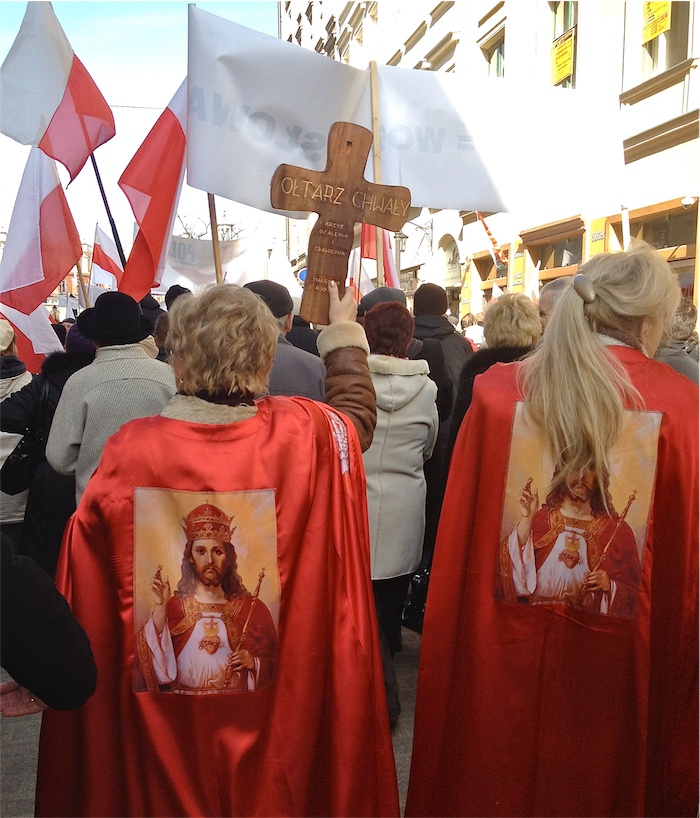
Marsz protestacyjny w obronie Telewizji Trwam. Kraków, marzec 2011, fotografia autorki.
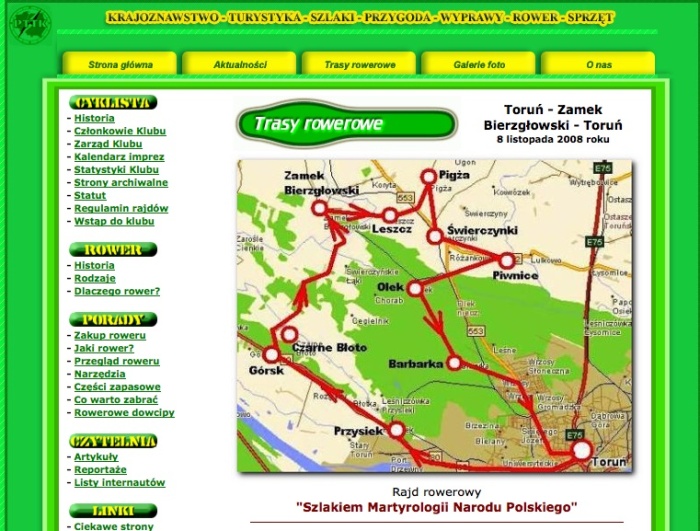
Mapa ze strony promującej turystykę rowerową, prezentująca liczący 38 kilometrów „Szlak martyrologii polskiej” w rejonie Torunia, autor: Zbigniew Suszyński; http://www.cyklista.q4.pl/t22_08.html
As they become real and close – embodied – these myths often acquire political traction and mobilize groups. Here, I build on the work of Emile Durkheim in the Elementary Forms of Religious Life, and expand from the frameworks of Benedict Anderson and Michael Billig to illuminate the process through which elite projects ultimately generate sentiments of national belonging below. Within a certain sensorium and aesthetics, elite projects can cue paradigmatic stories and sentiments, or their subversion in iconoclastic acts or the construction of alternative sensoria.
For reasons beyond the scope of this brief essay, the Catholic and martyriological version of Polishness has been increasingly contested since the fall of communism. The critique is articulated in various spheres of public life: in political discourse, constitutional debates, historical narratives, and artistic production (Zubrzycki 2001, 2006, 2012) (Figures 3 and 4)
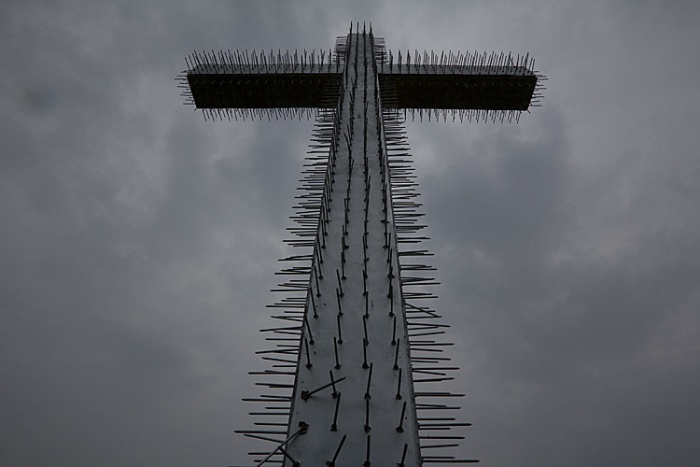
Krzyż fakira polskiego artysty Petera Fussa. Źródło: Peter Fuss, reprodukcja za zgodą artysty.
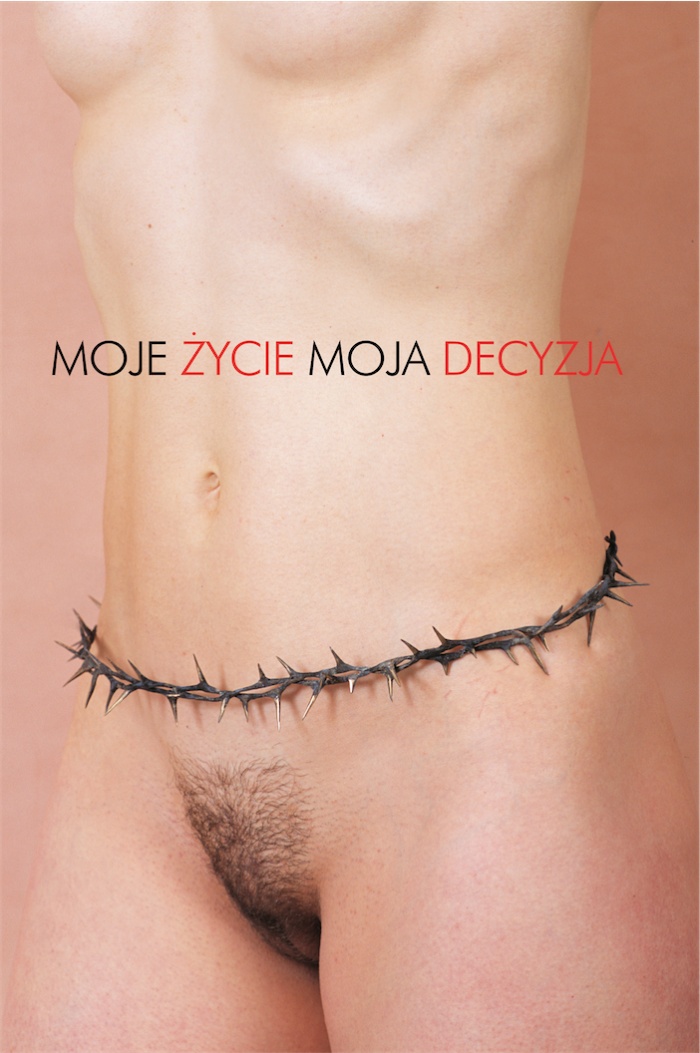
Moje życie, moja decyzja, Dorota Nieznalska, 2005. Projekt zdobył trzecie miejsce w konkursie zorganizowanym przez Federację na rzecz Kobiet i Planowania Rodziny. Źródło: Dorota Nieznalska, reprodukcja za zgodą artystki.
The current “Jewish turn” in Poland, characterized not only by the revival of Jewish communities but also by the initiatives of Polish memory activists as well as by many ordinary Poles to remember, commemorate, and even to resurrect Jewish culture in Poland, is part of that project of national redefinition (Waligórska 2008; Lehrer 2013; Zubrzycki 2016). By inscribing the Polish landscape with material markers of what were and are no longer – remnants of a former Jewish street, Jewish funerary stones used on a retaining wall, the site of the former Great Synagogue in Warsaw – a sense of void is created and Jewish absence can be felt by contemporary Poles (figure 5).
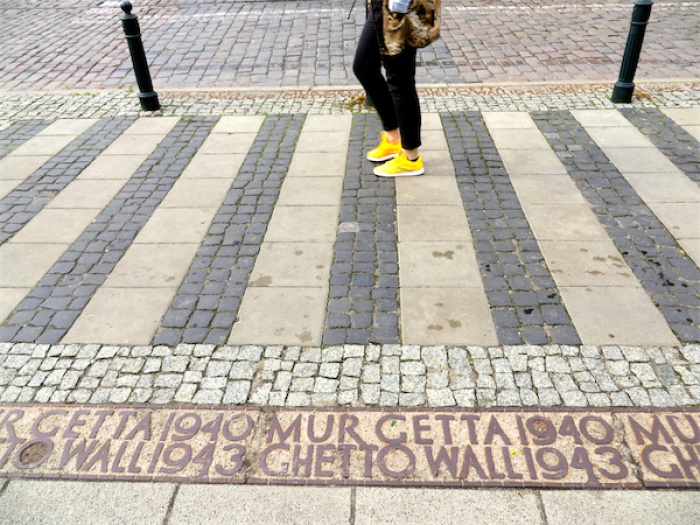
Ścieżka upamiętniająca mury getta warszawskiego. Źródło: Autorka, 17.05.2014
That void can be filled by visiting institutions like museums, which recreate the vanished Jewish world of pre-Holocaust Poland through material and phenomenological modes of storytelling; or by performing Jewish dances, learning Yiddish or Hebrew, or cooking and consuming Jewish foods. All these practices, these acts of salvage remembrance and performance, ultimately constitute, I argue, attempts by Polish social actors to expand and reshape the symbolic boundaries of the nation beyond the narrow confines of ethnonational Polishness and Catholicism. Here material void and traces, as well as embodied practices and performances, converge to create a Jewish sensorium that challenges the dominant (and extensive) Polish-Catholic one by complementing it, thereby providing the potential to expand notions of national identity.
Embodied Jewishness: Walking the Walk and Dressing the Part
While some wrap themselves in Jesus capes, others proudly wear yellow daffodils (Figure 6). In 2013, on the occasion of the seventieth anniversary of the Uprising, designer Helena Czernek created for the POLIN Museum of the History of Polish Jews a yellow paper daffodil to be worn as a pin to commemorate the Uprising. Some forty thousand were made and distributed by volunteers, and the paper daffodil could be seen worn by Poles for weeks after the commemorative events. The memento was effective because it linked the commemoration of the Uprising with the memory of Marek Edelman, who traditionally brought daffodils to the Rapaport Monument until his death in 2009. The paper daffodil was also semiotically complex. Once pinned, the yellow paper flower opened up and looked much like a star. Many affixed the flower/star to their lapels, others to their sleeves, replicating the branding of Jews during the Nazi occupation. Special commemorative marches and bike rides were organized, retracing the now vanished traces of Jewish Warsaw.
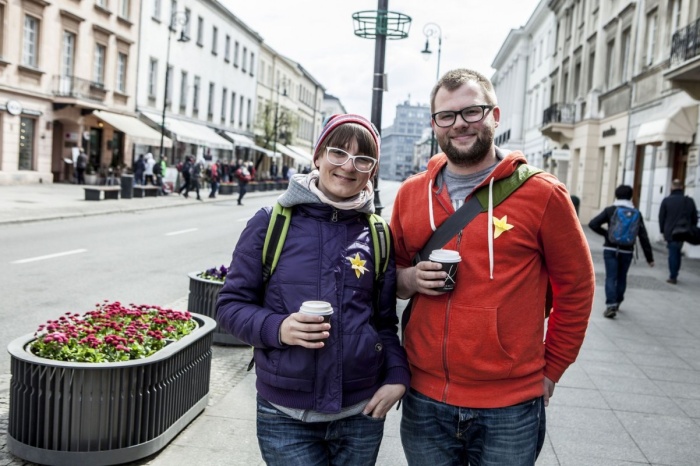
Para młodych ludzi z żonkilami na warszawskim Nowym Świecie. Chłopak ma przypiętego żonkila, a dziewczyna wersję „rozkwitłą” w gwiazdę Dawida. Źródło: Alicja Szulc, Muzeum Historii Żydów Polskich POLIN, 19 kwietnia 2015.
The paper daffodil has now become an established tradition that has grown in popularity and been extended to the four corners of Poland. On 19 April 2017, over one thousand volunteers distributed 100,000 thousand paper daffodils in Warsaw alone. One thousand schools in various regions of Poland made additional daffodils and distributed them in their small towns and villages.[4] While the daffodil flower has come to symbolize, over the years, the memory of the Uprising, its paper incarnation that mutates into a yellow star has acquired an additional signification, that of the Holocaust and the fate that separated Jewish from non-Jewish citizens of Poland.[5] Wearing the paper daffodil/star has therefore become a commemorative act as well as a posthumous act of resistance to the distinction made by Nazis (and by many Poles) between Jews and non-Jews.
While events commemorating the Holocaust in Poland are not new, their scope and reach have increased since 1989. In Kraków, for example, the March of Memory commemorates the liquidation of the Jewish ghetto every year. Participants walk from the Podgórze neighborhood, where Jews were relocated in a ghetto, to the Płaszów work camp. It takes on meaning for its participants as an embodied practice attempting to replicate the forced migration of Jews; as practiced and walked history. These embodied and publically performed rituals simultaneously allow Polish-Jewish history to be phenomenologically internalized by individuals, and externalized onto the material cityscape. The material and performative remaking of public space in turn motivates political discourses about citizenship and what constitutes Polishness. The effect is to not only materially and performatively but also discursively reject a vision of ethnic Polishness narrowly predicated on its association with Catholicism.
Dressing the Part
While many “national” practices are ritual-like (e.g., commemorations, perambulations), educational (e.g., museums, workshops), or festive (e.g., holidays, festivals), many others are mundane. Many Poles indeed engage in daily, mundane “Jewish” activities: they listen to Jewish music, from modern klezmer to Israeli hip-hop; they eat in Jewish restaurants and drink kosher vodka; and some even “dress Jewish.” What do consumption patterns and individual practices mean to those engaging in them?
A fashionably contemporary clothing label in Warsaw that recently launched a new “Jewish” line called “Risk Oy” may offer clues. Initially targeted at young Jews, Risk Oy produces pricey T-shirts and hoodies with slogans such as “Thanks to my Mom” (in English), adorned with a variety of Star of David designs and Hebrew inscriptions. The owner of the brand told the Times of Israel: “What we really want . . . is to rebrand Jewish identity. We want to show the modern, positive aspects of it. What we are doing is showing that being Jewish is cool and sexy.”[6] The clothes are not bought and worn by Jews alone, however. One non-Jewish customer quoted in the story, a forty-year-old lawyer living in Warsaw, explained, “Wearing [Risk Oy] is like taking part in a public discussion about Jews in Poland – that Jews live here and that Jews can live here.” This is a important comment on two levels: first, because it emphasizes that public discussion about Jews in Poland is actually one about the very identity of Poland and a critique of the still dominant vision of the nation as ethnically Polish and (nominally) Catholic; and second, because it indicates that this public discussion is taking place not only in the pages of newspapers and the discourses of public intellectuals, but also on the streets among hoi polloi and the clothes they wear (or the music they listen to, or the bars they patronize). The NGO Foundation for Freedom several years prior (2010) had produced “I’m a Jew” T-shirts as part of a campaign that consisted in “spreading . . . slogans signaling the existence of . . . discriminated social groups in Poland,” including Jews, atheists, and gays.[7] Hence some liberal, leftist youth wore T-shirts and brandished posters in protests against clerical nationalists, subversively claiming that they were “Jews.” With this display they mocked anti-Semitic conspiracy theories of the right claiming that Jews rule Poland, but they also called for a different kind of Poland, one in which the right’s distinctions between “real Poles,” “Jews,” and “bad Poles” would have no political traction.
Consuming Jewish food, whether in its Ashkenazi form or in its contemporary Israeli versions, is also a way to acquaint oneself with either the “known” and recognizable (Ashkenazi cuisine being very similar to Polish cuisine) or the mysterious and exotic (Israeli cuisine). It is that mix of “ours” and “other,” of the familiar and the exotic, that likewise attracts many (non-Jewish) young women who take part in an Israeli dance group. A (non-Jewish) dancer in a Polish dance troupe focused on Israeli dancing in its multiple forms, explained to me that “On one hand, [Jewish culture] is, let’s say, ‘Oriental.’ But on the other hand, because it developed in Poland, in spite of everything it’s somehow very much tied with Poland, yes? It’s kind of an exotic element in our environment. It’s not something like . . . Swahili somewhere far off in Africa, but [rather] something that is different from Polish culture yet at the same time related to it, inseparable even.”
Performing various forms of Jewish dances – Ashkenazi, Sephardic, or contemporary Israeli – brings those dancers (and, one presumes, their audiences) closer to a different side of Polish history than the one exalted in Polish national mythology and its sensorium. At the same time, as this woman’s explanation suggests, the dances transport them to faraway, exotic, “Oriental” (yet, paradoxically, more “Western” than Poland) – places like Israel (Figure 7).

Wearing a “Jewish” sweatshirt, dancing to Jewish music, eating Jewish foods, and drinking kosher vodka become embodied practices that can challenge a restrictive definition of Polishness. These practices do not serve to reproduce an existing national identity but to de- and re-construct identity along new lines. Polishness is being challenged and redefined by activists and artists as well as by ordinary people in their mundane activities. Multiple forms of memory work such as graffiti art, walking tours of formerly Jewish spaces, commemorative marches, or the cleaning and restoration of cemeteries all serve to undermine the political claim and the dominant view that Poland is essentially, primordially ethno-Catholic. Ordinary Poles become involved in the Jewish revival and assimilate Jewishness through embodied and repeated actions. They remake Polishness by learning how to “cook Jewish” or how to serve and consume Jewish foods during a festival, at a café all year round, or at a Sabbath dinner at the JCC; by singing and dancing; by learning Jewish paper-cutting techniques; or by donating their time and energy to Jewish individuals and organizations.
Evocative as these examples are, we should ask whether they reach large enough audiences to be significant, or to constitute a bona fide social movement. Do they remain elite practices by artists and activists that do not quite resonate en masse? How successful are the mnemonic recovery of material traces and the embodied practices rehearsed by attempting to follow the footsteps of Jews who no longer live in Poland? From the perspective of a sociology of national identity, it is not yet clear how to define the “success” of these practices. One way to adjudicate or at least gain perspective on the issue, is to pay close attention to the Polish national sensorium. We can speak of a revived Jewishness in Poland to the degree that Jewish histories are discovered, named, and animated and to the degree that the proper attunement to their material traces is cultivated – not only among memory activists and cosmopolitan consumers, but also as a matter of public pedagogy and city planning. By this measure, a Jewish turn is well underway, though its effects in reforming Poland’s national identity, or the manifold ways it is subjectively internalized, are still unclear.
References
Anderson, Benedict. (1983) 1991. Imagined Communities: Reflections on the Origins and Spread of Nationalism. New York: Verso.
Biddle, Ian and Vanessa Knights (Eds). Music, National Identity and the Politics of Location: Between the Global and the Local. London: Ashgate.
Billig, Michael. 1995. Banal Nationalism. London: Sage.
Cerulo, Karen A. 1995. Identity Designs: The Sights and sounds of a Nation. New Brunswick: Rutgers University Press.
DeSoucey, Michaela. 2010. “Gastronationalism Food Traditions and Authenticity Politics in the European Union.” American Sociological Review 75: 432–455.
Hirsh, Dafna. 2013. “Hummus: The Making of an Israeli Culinary Cult.” Journal of Consumer Culture 13(1): 25–45.
Ichijo, Atsuko, and Ronald Ranta. 2015. Food, National Identity and Nationalism: From Everyday to Global Politics. London: Palgrave Macmillan.
Lehrer, Erica. 2013. Jewish Poland Revisited: Heritage Tourism in Unquiet Places. Bloomington: Indiana University Press.
Molnár, Virág. 2017. “The Mythical Power of Everyday Objects: The Material Culture of Radical Nationalism in Postsocialist Hungary” in Geneviève Zubrzycki (ed) National Matters: Materiality, Culture, and Nationalism. Palo Alto: Stanford University Press.
Napiorkowski, Marcin. 2015. “Zaproszenie do kultury wernakularnej.’ Kultura wspolczesna. 3 (87).
Waligórska, Magdalena. 2008. “Fiddler as a Fig Leaf: The Politicization of Klezmer in Poland.” In Manfred Sapper (ed.), Impulses for Europe: Tradition and Modernity in East European Jewry. Berlin: Osteuropa, 227–238.
Waligórska, Magdalena. 2013. Klezmer’s Afterlife: An Ethnography of the Jewish Music Revival in Poland and Germany. New York: Oxford University Press.
Zubrzycki, Geneviève. 2001. “‘We, the Polish Nation’: Ethnic and Civic Visions of Nationhood in Post-Communist Constitutional Debates.” Theory and Society 30(5): 629–669.
Zubrzycki, Geneviève. 2012. “Odczuwając naród: Estetyka martyrologii mesjanistycznej w Polsce,” Sensus Historiae. Studia interdyscyplinarne, 3:1, 49-76. Translated by Maciej Sawicki.
Zubrzycki, Geneviève. 2014. Krzyże w Auschwitz. Tożsamość narodowa, nacjonalizm i religia w postkomunistycznej Polsce. Kraków: NOMOS. 295 pp. Translated by Paweł Tomanek. (Original: The Crosses of Auschwitz: Nationalism and Religion in Post-Communist Poland. Chicago: The Univesity of Chicago Press, 2006).
Zubrzycki, Geneviève. 2016. “Nationalism, ‘Philosemitism’ and Symbolic Boundary-Making in Contemporary Poland.” Comparative Studies in Society and History, 58(1): 66-98.
BIO
Geneviève Zubrzycki is Associate Professor of Sociology and Director of the Weiser Center for Europe and Eurasia at the University of Michigan. Her work examines politics and religion, nationalism, as well as national mythology and the politics of commemorations. Her book The Crosses of Auschwitz: Nationalism and Religion in Post-Communist Poland (2006) received awards from the American Sociological Association, the Association for Slavic, East European and Eurasian Studies, and the Polish Studies Association. It appeared in Polish as Krzyże w Auschwitz. Tożsamość narodowa, nacjonalizm i religia w postkomunistycznej Polsce in 2014. She is also the author of Beheading the Saint: Nationalism, Religion and Secularism in Quebec (2016), and the editor of National Matters: Materiality, Culture, and Nationalism (2017).
[1] Synesthesia is the “transposition of sensory images or sensory attributes from one modality to another” (Marks 1978, 8) which “express... a relationship between features of experience that properly belong to different senses” (1).
[2] On vernacular culture, see Marcin Napiorkowski (red), “Kultura wernakularna. Pamięć - wyobraźnia - praktyki oporu,” Kultura Wspołczesna, 3/2015.
[3] On the recent commodification of nationalist ideologies through the commercial spread of “patriotic clothing,” see Virag Molnar (2017).
[4] See: http://www.polin.pl/pl/aktualnosci/2017/04/12/to-juz-piata-edycja-akcji-spoleczno-edukacyjnej-zonkile-19 (accessed 19 April 2017).
[5] Helena Czernek told me she had never intended the daffodil to be a yellow star; that it was a material flaw caused by nothing more than poor glue and problematic execution by the volunteers who had assembled the paper flowers. It is however precisely that additional, accidental signification that made the small paper memento such an impactful one.
[6] At: www.timesofisrael.com/polish-fashion-entrepreneur-makes-being-jewish-sexy/?utm_source=Newsletter+subscribers&utm_campaign=0c5a586595-JTA_Daily_Briefing_1_31_2014&utm_medium=email&utm_term=0_2dce5bc6f8–0c5a586595–25416689 (accessed 1 February 2014).
[7] Other T-shirts part of the 2004 campaign included, “I don’t go to church,” “I don’t want to have kids,” or “I’m gay.” See www.tiszertdlawolnosci.tiszert.com (accessed 22 July 2012).



